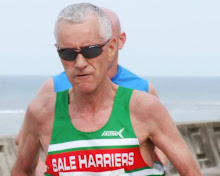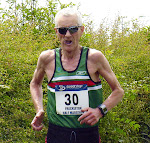Q1. PERSONAL BESTS
880 yards (2.00mins)(Stretford
1967)
MILE 4.26 (grass track barefeet)(Wigan 1966)
2K steeplechase 5.59.2 (AAA champs 3rd)(Liverpool 1967)
5K track
15.18.6 (Leeds Carnegie) (1986)
10K road
31.30 (Toronto
10M road
51.14 (York
1/2 Marathon 67.55 (York
Marathon
2.25.36 London
Q2.What do you regard as your biggest achievement?
Difficult! Torn between the 2:25:36 marathon
PB, the 2 marathons I actually won, a 3rd in a National championship
(steeplechase) the 3:13 in the 3 Peaks. In terms of performance running 34.58
at the age of 50 in your own SALFORD 10K might
well be my best performance as it equates
to 30.20 on age graded tables. In terms of longevity 114 10ks under 40
minutes.
Q3. After such a long and distinguished career, what
is it about running and competing that keeps you motivated?
I think old guys like me who refuse to stop
running and racing are “sticking to
fingers up” to Father Time. We’re saying, “OK, we’re getting older but hey we
can still do what we did as a teenager ,just a bit slower!” We’re helped by the great numbers of novice
runners taking up the sport, as in races
we’re still relatively high up in the field. But the key to it all is simply
building enough variety into training that it remains enjoyable.
Q4.You have had your fair share of injuries and
illnesses, was there ever a time when you felt like just packing it in?
I have suffered setbacks,
but there are countless years
over the last few decades when I haven’t missed a day’s running (but I’m not
obsessive about it.) I tend to deal with niggles a.s.a.p.myself rather rushing
off to a physio.
But,yes, the series of lung collapses I
suffered at the age of 18/19 when I was just making my mark in senior
competition were traumatic.
I recall drinking a pint of Boddingtons Best
in the Halfway House Pub at the corner of Cheetham Hill and feeling air coming
out of the lung into my back. 10 minutes later I was in Crumpsall A.& E.
The Morton’s Neuroma was very unpleasant to
endure. It’s a very painful growth in the forefoot which I had to have cut out
in 2002. Paula Radcliffe suffered similarly. Once it was diagnosed, I just
wanted to sort the problem out and start running again.
The asthma was more difficult to detect and
before being prescribed the inhalers I did say I wouldn’t race again as
performance deteriorated. But again it was overcome.
A lot of runners, who have run much faster
times than me, have stopped racing at their best. They have not wished to
continue competing and record slower times. I’ve just accepted the inevitable;
that, except for the late starters, we will slow with age. But I still enjoy
competing, trying to beat the guys and gals I’m shoulder to shoulder with after
the first mile!
Q5. What do you regard as the best period in your
running career and what was so special about that time?
Running is essentially an individual pursuit
but I think when you’re part of a successful team and performing well
individually at the same time it’s special. I experienced that with SALE Manchester League, East
Lancs Champs, the Northern and won the National Cross Country.
Having said I still trained in Higher Blackley largely by myself. Being
isolated I needed to develop SELF MOTIVATION and that hasn’t changed throughout
my career. If a runner relies too much on group training it’s fine until the
group breaks up.
As a senior runner, my best period was the
mid 1980s when I was aged
33 to 38 I would say.
Q6.How would you explain/describe the
differences/changes in the running community over the years?
When I started running/racing in 1963 you
could count the number of male runners on one hand and one finger for the lady
who ran! Clubs recruited members largely by approaching the best kids in the
schools cross country races. So the clubs were largely made up of quality
runners. Very few senior runners would run over 60 minutes for 10 miles, for
example. Marathons would have less than 100 in them.
But with the growth in popularity of the
marathon from the early 1980s we now see thousands upon thousands of people
running and racing. A whole spectrum of ability, all shapes and sizes and of
course a massive increase in the number of ladies! It’s tremendous.
What puzzles my generation is that with so
many more people participating it could be expected that distance performances
would improve as well. But sadly this is not the case. My 2;25;36 would have
placed me 28th in this year’s London
That year 1983 103 UK
But ultimately it has to be
good that thousands are now enjoying an activity which we have derived so much
pleasure from for all these years.
Q7. What would you say was the secret to churning out
continuous great times on the road over numerous distances and over so many
years.
Self motivation.
I’ve guided all my training and racing as a senior athlete. Have realistic aims
based on your work and family commitments and build in a variety of training to
achieve those aims. Target a few KEY
races throughout the year which REALLY matter interspersed with “tune up races”
on the way.
Don’t overdo road work, don’t overdo track
training, don’t overdo hill training, build in recovery days of gentle jogging.
Variety is the key. Don’t be afraid to say “no that sessions not right for ME
tonight”
Q8.If there was one race you would recommend everyone
do, what would it be and why?
The mass participation races
do have a real “buzz” about them and that inner glow on a Sunday night having
run a marathon is very memorable. But I wouldn’t recommend doing say the London or Manchester
I would rather recommend an improving runner
focuses on running an even paced 10K than completing a marathon with a massive
positive split. But it’s the marathon which is the “party” every new runner
wants to go to whatever their weight, lifestyle or existing fitness level.
Specifically, I would recommend a club trip to
Amsterdam
Q9. Is there a race that you have fond memories of and
which no longer exists and you wish would re-establish itself? Why?
Not really. But
sad we’ve lost the SALE 10 having already seen
the Sale
Q10. Who LOCALLY do you regard as the best runner
Past/present that you have seen?
It’s comes back to
achievements and longevity really and who can rival what RON
HILL has achieved on the track, on the road and on the
country. A 2.09 marathon and winning the national xc, hard to beat.
Q11. A local runner yourself who ran for a number of
clubs, was there never a point you came close to joining Salford
Harriers?
When I finished 7th
in the Manchester Schools XC Champs it seemed everyone was saying I should join
this and that club including SALFORD.
But ALAN ROBERTSHAW was very
proactive in his recruiting of runners from both south and north Manchester and so I joined SALE
HARRIERS, running with them for 10 years until I came to Yorkshire .
Returning to the club in 2009 was largely
based on nostalgia but it has been put to me, quite rightly, that SALFORD ’S vets section would have been a better bet!
Q12. Lastly, please tell us everything you know about Salford Harriers and their runners Past/Present.
How long have you got? I
have 50 years of knowledge and have the book describing the history of the
club! JOHN TARRANT , the “ghost runner” and all that! Every Salford
member should know his running story.
I’ve seen SALFORD
HARRIERS develop into one of the top harrier clubs in the country. A force to
be reckoned with and may it continue!
Personalities? I never felt any real
resentment that living in Higher Blackley I should really have joined SALFORD . GEOFF DOGGETT and JOE LANCASTER always had a kind
word for me. I got on well with STAN CURRAN, STAN CLEGG, ALAN SLADEN, GODFREY
CLAFF and of course one of your most successful runners ever ARTHUR WALSHAM.
I hope younger members of SALFORD
respect and perhaps learn from the great success that STAN CURRAN and ARTHUR
WALSHAM have had in their long careers. Tremendous.
Q13. What are your future aims and aspirations?
Essentially to enjoy
running WISELY on a DAILY basis in order to keep competing
in 15/20 races per year. I managed 114 10Ks under 40 minutes and so now the
current aim is to try to do 150 10ks under 44 minutes.
But it’s not going to be easy! Might give the
Boggart Chase a miss this year as that would be one I certainly wouldn’t go
under 44 mins on!










No comments:
Post a Comment